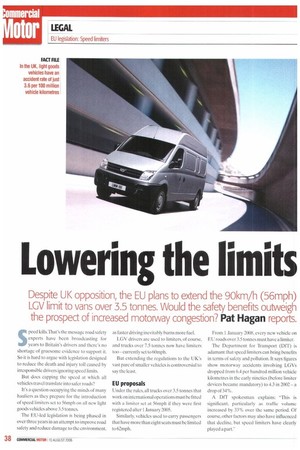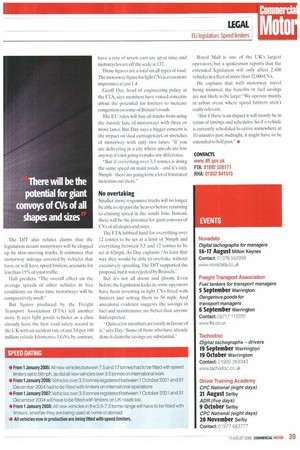Lowering the limits
Page 38

Page 39

If you've noticed an error in this article please click here to report it so we can fix it.
Despite UK opposition, the EU plans to extend the 90km/h (56mph) LGV limit to vans over 3.5 tonnes. Would the safety benefits outweigh the prospect of increased motorway congestion? Pat Hagan reports.
Speed kills. That's the message road safety experts have been broadcasting for years to Britain's drivers and there's no shortage of gruesome evidence to support it. So it is hard to argue with legislation designed to reduce the death and injury toll caused by irresponsible drivers ignoring speed limits.
But does capping the speed at which all vehicles travel translate into safer roads?
It's a question occupying the minds of many hauliers as they prepare for the introduction of speed limiters set to 56mph on all new light goods vehicles above 3.5 tonnes.
The EU-led legislation is being phased in over three years in an attempt to improve road safety and reduce damage to the environment, as faster driving inevitably burns more fuel.
LGV drivers are used to limiters, of course, and trucks over 7.5 tonnes now have limiters too currently set to 60mph.
But extending the regulations to the UK's vast parc of smaller vehicles is controversial to say the least.
EU proposals
Under the rules, all trucks over 3.5 tonnes that work on international operations must be fitted with a limiter set at 56mph if they were first registered after 1 January 2005.
Similarly, vehicles used to carry passengers that have more than eight seats must be limited to 62mph. From 1 January 2008, every new vehicle on FU roads over 3.5 tonnes must have a limiter.
The Department for Transport (Df I') is adamant that speed limiters can bring benefits in terms of safety and pollution. It says figures show motorway accidents involving LGVs dropped from 6.4 per hundred million vehicle kilometres in the early nineties (before limiter devices became mandatory) to 4.3 in 2002a drop of 34%.
A DfT spokesman explains: "This is significant, particularly as traffic volume increased by 33% over the same period. Of course, other factors may also have influenced that decline, hut speed limiters have clearly played a part. The DfT also refutes claims that the legislation means motorways will be clogged up by slow-moving trucks. It estimates that motorway mileage covered by vehicles that have, or will have, speed limiters, accounts for less than 15% of total traffic.
Hall predicts: "The overall effect on the average speeds of other vehicles in free conditions on three-lane motorways will be comparatively small."
But figures produced by the Freight Transport Association (ETA) tell another story. It says light goods vehicles as a class already have the best road safety record in the UK with an accident rate ofjust 3.6 per 100 million vehicle kilometres. LGVs. by contrast, have a rate of seven; cars are up at nine; and motorcycles are off the scale at 137.
Those figures are a total on all types of road. The motorway figure for light CVs is even more impressive at just 1.4.
Geoff Day, head of engineering policy at the FTA, says members have voiced concerns about the potential for limiters to increase congestion on some of Britain's roads.
The EU rules will ban all trucks from using the outside lane of motorways with three or more lanes. But Day says a bigger concern is the impact on dual carriageways, or stretches of motorway with only two lanes: If you are delivering in a city where speeds are low anyway it's not going to make any difference.
"But if everything over 3.5 tonnes is doing the same speed on main roads — and it's only 56mph— there are going to be a lot of frustrated motorists out there."
No overtaking
Smaller, more responsive trucks will no longer be able to zip past the heavies before returning to cruising speed in the inside lane. Instead, there will be the potential for giant convoys of CVs of all shapes and sizes.
The ETA lobbied hard for everything over 12 tonnes to be set at a limit of 56mph and everything between 3.5 and 12 tonnes to be set at 62mph. As Day explains: "At least that way they would be able to overtake without excessively speeding. The .DfT supported the proposal, but it was rejected by Brussels."
But it's not all doom and gloom. Even before the legislation kicks in, some operators have been investing in light CVs fitted with limiters and setting them to 56 mph. And anecdotal evidence suggests the savings in fuel and maintenance are better than anyone had expected.
"Quite a few members are totally in favour of it," says Day. -Some of those who have already done it claim the savings are substantial." Royal Mail is one of the UK's largest operators, but a spokesman reports that the extended legislation will only affect 2,400 vehicles in a Beet of more than 32,000 CVs.
He explains that with motorway travel being minimal, the benefits in fuel savings are not likely to be large: "We operate mainly in urban areas, where speed limiters aren't really relevant.
"But if there is an impact it will mostly be in terms of timings and schedules. So if a vehicle is currently scheduled to arrive somewhere at 10 minutes past midnight, it might have to be extended to half past." •




























































































































































































